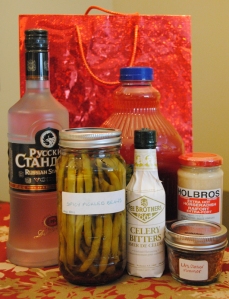A jar or two of pickles, jam, sauce and relish is always a welcome gift among our families and friends.
But, for the holidays, we like to take it up a notch. This year, we created two entirely different themed gifts, both containing preserves — one for David’s parents and one for David’s brother and sister-in-law.
Caesar kit
This gift started with my spicy pickled beans — a great Caesar garnish — and evolved almost serendipitously from there.
During a trip to New York State this summer, we discovered the Fee Brothers celery bitters (and fortuitously, a local kitchen store began stocking them this fall). A dash or two will add a distinct celery flavour to your drink without the saltiness of, well, celery salt.
David’s mom has developed a taste for expensive vodka. We thought it time to introduce her to Russian Standard, a premium wheat vodka sold at a very reasonable price.
Horseradish is must in a Caesar in my opinion. Holbros Extra Hot is our favourite brand.
David thought we needed a rimmer; I refused to go with celery salt. I searched the web and found a recipe for tomato basil dust on Cottage Life, which I adapted for this purpose.
Tomato Basil Dust
Adapted from Cottage Life.
Ingredients
115 g (4 oz) sun-dried tomatoes
15 mL (1 tbsp) dried basil
15 mL (1 tbsp) of Murray River pink flake salt
5 mL (1 tsp) fresh ground black pepper
Method
Finely chop sun-dried tomatoes. Dry on parchment-lined baking sheet in 175 Fahrenheit oven for 1-1⁄2 to 2 hours. Turn off heat, open oven door, and allow to cool.
In electric grinder, grind small amounts of dried tomato to a fine powder.
Sift tomato powder into bowl, regrinding any large granules.
Mix in the remaining ingredients.
Store in tightly sealed jar away from light, heat and moisture.
Barbecue gift pack
The idea for this gift came from the recipient. David’s brother enjoys barbecuing but expressed an interest in expanding his repertoire.
So, I printed out three of our favourite recipes, Maple Dijon Cedar-Planked Salmon, Spatchcock Mustard Herb Chicken and Bourbon Glazed Striploin Roast, and assembled the ingredients (minus the protein and a few basics like oil, salt and pepper) to make all three.
David cut a cedar plank from his stash for the salmon, we added a silicone glove for safety and tucked it all into a grilling basket (good for sides of potatoes or vegetables).
The basket also includes three on-theme preserves: corn relish, dill pickle relish and barbecue sauce.
Here are the recipes we included. The spatchcock chicken recipe comes from Canadian Living. The origins of the others are a mystery.
Maple Dijon Cedar-Planked Salmon
Ingredients
salmon fillet (or steelhead trout or rainbow trout)
maple syrup
Dijon mustard
cedar plank
Method
Soak cedar plank it water for at least 4 hours or overnight.
Mix together equal parts maple syrup and Dijon.
Put fish on plank. Brush with half of glaze.
Place plank on hot grill. Cook for 15-20 minutes, brushing with remaining glaze halfway through.
Time will depend on size and thickness of fillet. Fish will be firm and opaque when ready.
Spatchcock Mustard Herb Chicken
Spatchcock, which means removing the backbone of a chicken and flattening it out, is an old Irish term, abbreviated from dispatch cock, an order barked at cooks to get the chicken off the spit and out to the customer. Flattening a whole chicken means that you can grill it over direct heat in less than an hour.
Ingredients
1-1/2-2 kg (3-4 lb) whole chicken
60 mL (1/4 cup) Dijon mustard
30 mL (2 tbsp) chopped fresh herbs or 15 mL (1 tbsp) dry (tarragon, rosemary or thyme)
30 mL (2 tbsp) wine vinegar
30 mL (2 tbsp) vegetable oil
2 mL (1/2 tsp) each salt and pepper
Method
In small bowl, stir mustard, herbs, vinegar, oil, salt and pepper. Set aside.
Using kitchen shears, cut chicken down each side of backbone. (Remove backbone and save for stock.)
Turn chicken breast side up; press firmly on breastbone to flatten. Tuck wings behind back.
Place in shallow glass dish; brush with mustard mixture. Cover and refrigerate for 8 hours.
Place chicken, bone side down, on greased grill over medium heat. Close lid and grill, turning once, until juices run clear when thigh is pierced, 50 minutes.
Transfer to cutting board. Tent with foil; let stand for 10 minutes.
Bourbon Glazed Striploin Roast
Ingredients
1-1/2-2 kg (3-4 lb) well-marbled striploin
80 mL (1/3 cup) bourbon
80 ml (1/3 cup) soy sauce
30 mL (2 tbsp) brown sugar
30 mL (2 tbsp) wine vinegar
30 mL (2 tbsp) vegetable oil
2 mL (1/2 tsp) fresh ground pepper
1 small onion, diced
1 clove garlic, minced
Method
Combine all ingredients except striploin
Place marinade and roast in plastic container and refrigerate for 8 hours or overnight, turning roast occasionally to ensure even marinating.
Place drip pan under grill. Heat barbecue to approximately 400 Fahrenheit.
Place roast on grill and cover. Cooking time will depend on size of roast and desired doneness. Check temperature after 25 minutes.
Transfer roast to cutting board. Rest for 10-15 minutes before slicing.







